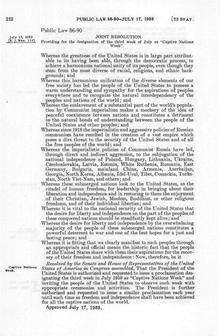Captive Nations
"Captive Nations" is a term sometimes used in the United States to describe nations under undemocratic regimes. During the Cold War, when the phraseology appeared and was more frequently used, it referred to nations under Communist domination, primarily Soviet rule.
As a part of the United States' Cold War strategy, an anti-Communist advocacy group, the National Captive Nations Committee, was established in 1959 according to Pub.L. 86–90 by President Dwight D. Eisenhower. The American economist and diplomat of Ukrainian heritage Lev Dobriansky played a key role in it.[2]
The law also established Captive Nations Week, traditionally proclaimed for the third week in July since then. The move aimed at raising public awareness of the problems of nations under the control of Communist and other non-democratic governments.
The original Public Law 86-90 specifically referred to the following Captive Nations:[3]

- Poland
- Hungary
- Lithuania
- Ukraine
- Czechoslovakia
- Latvia
- Estonia
- White Ruthenia (Belarus)
- Romania
- East Germany
- Bulgaria
- Mainland China
- Armenia
- Azerbaijan
- Georgia
- North Korea
- Albania
- Idel-Ural
- Tibet
- Cossackia
- Turkestan
- North Vietnam
Criticism
Russian emigres living in US, criticized P.L. 86-90, because speaking of "Russian communism" and "imperialistic policies of Communist Russia" this law by implication equated the terms "Russian", "Communist" and "Imperialist". Specifically, the Congress of Russian Americans argued that P.L. 86-90 was anti-Russian rather than anti-Communist since the list of "captive nations" did not include Russians, thus implying that the blame for the Communist crimes lies on the Russians as a nation, rather than just on Soviet system. According to the Russian writer Andrei Tsygankov, the suggested reason for this is that the law was designed by Lev Dobriansky viewed by the Russian Americans as a Ukrainian nationalist.[4] Members of the Congress have campaigned for nullification of the Captive Nations law.[5]
A group of prominent American historians issued a statement claiming that PL 86-90 was largely based on misinformation and committed the United States to aiding ephemeral "nations" such as Cossackia and Idel-Ural.[6]
Gregory P. Tschebotarioff, Stephen Timoshenko, Nicholas V. Riasanovsky, Gleb Struve, Nicholas Timasheff were among opponents of the PL 86-90.
Current vision
American leaders continue the tradition of celebrating Captive Nations Week and each year issue a new version of the Proclamation. Contemporary Proclamations do not refer to particular nations or states. The latest US President to specify a list of countries with oppressive regimes was George W. Bush, whose 2008 Proclamation mentioned Belarus and North Korea (in 1959 Belarus was denoted as White Ruthenia). George W. Bush characterized the leaders of the two countries as 'despots'.[7]
When declaring the July 2009 Captive Nations Week, President Barack Obama stated that while the Cold War was over, concerns raised by President Eisenhower remained valid.[8][9]
See also
References
- "Eisenhower's 165 News Conference". The American Presidency Project. July 22, 1959. Retrieved April 23, 2011.
- Edwards, Lee (February 14, 2008), Remembering ‘Mr. Captive Nations’ Lev Dobriansky. HumanEvents.com Archived March 18, 2008, at the Wayback Machine
- Campbell, John Coert (1965), American Policy Toward Communist Eastern Europe: the Choices Ahead, p. 116. University of Minnesota Press, ISBN 0-8166-0345-6
- Tsygankov, Andrei (2009). Russophobia: Anti-Russian Lobby and American Foreign Policy. Palgrave MacMillan. ISBN 978-0-230-61418-5.
- Anatoly Bezkorovainy (2008). All Was Not Lost: Journey of a Russian Immigrant from Riga to Chicagoland. AuthorHouse.
- "A Statement on U.S. Public Law 86-90". Russian Review. 20 (1): 97–98. 1961. JSTOR 126589.
- http://www.gpo.gov/fdsys/pkg/FR-2008-07-23/pdf/08-1464.pdf
- Captive Nations Week, 2009 – A Proclamation by the President of the United States of America. The White House Office of the Press Secretary. July 17, 2009
- Dale, Helle C. (August 24, 2009), Captive Nations Past and Present Archived 2010-01-25 at the Wayback Machine. The Heritage Foundation.